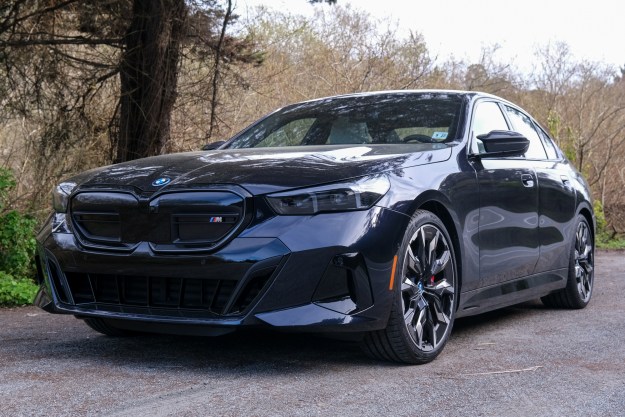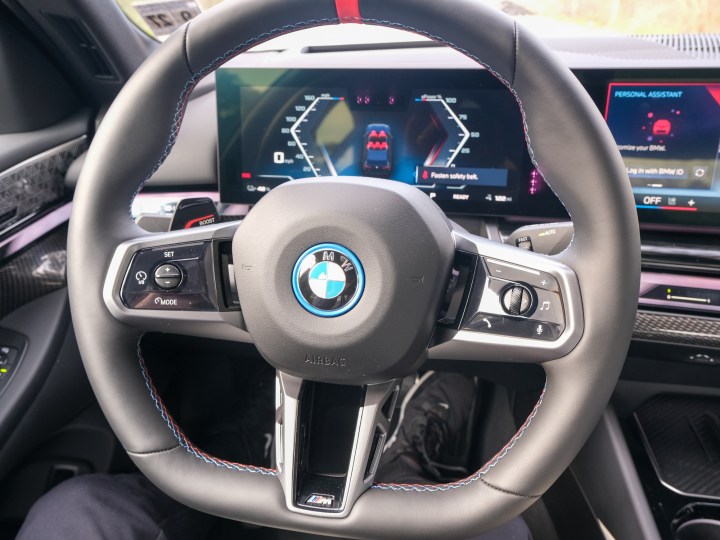
“The i5 M60 isn’t just fast and luxurious, it’s BMW’s best EV.”
- Sleek exterior
- Stunning interior
- Very fast performance
- Good handling
- Lower range in high-performance model
- No physical climate controls
BMW is far from new to the EV game. The company was actually pretty quick to adopt electrification, and it currently sells a series of EVs, from the SUV-sized iX to the high-performance i7. But now, the 5-series is getting the electric treatment, too — in the form of the new BMW i5.
The electric 5-series offers many similarities to its gas-powered counterparts. That’s a good thing. The i5 boasts a luxurious interior, incredibly fast performance, and a sense of style that puts some oversized-kidney-grille-bearing BMWs to shame.
The 2024 i5 is available in two models — the slightly more practical i5 eDrive40 and the more fun i5 M60 (an upcoming 2025 vehicle will add a third model to the lineup). The i5 M60 is the model we’re reviewing, and it’s perhaps BMW’s best EV yet.
Design and interior
The BMW i5 M60 is a seriously handsome car that perhaps offers everything great about BMW design over the past few years while doing away with the not-so-great. BMW has thankfully resisted the urge to adorn the car with oversized kidney grilles in favor of the more understated grilles that have defined BMW for years. Of course, on the i5 M60, it’s a faux grille — but while these often seem out of place on other EVs, it looks fine here.

The front of the car is nice and long, with an angled hood and flat nose. At the front, you’ll get slim and swooping headlights that match the very slim taillights. There are some aspects of styling that don’t fully make sense on an EV — like the grilles — but fans of the 5-series will love the look overall.
The interior continues the trend of stunning design. The car is very reminiscent of the i7 but without the interior features that made the i7 feel a bit over-the-top. Don’t expect a 31-inch TV in the back seat of the BMW i5 M60. Apart from that, though, there are plenty of similarities. At the front of the car, you’ll get a huge 12.3-inch digital instrument cluster, along with a 14.9-inch infotainment display. The seats are covered in a very premium-feeling stitched leather, and the steering wheel is nice and thick.

The BMW i5 M60 represents the best of what 5-series design can be. Both inside and out, it’s a great-looking car.
Tech, infotainment, and driver assist
As mentioned, the BMW i5 features a large display at the front for both instrument monitoring and infotainment. The car comes with BMW’s iDrive 8.5 infotainment system, and I found that BMW is making meaningful improvements to the software. However, I still used CarPlay at all times, except when testing for this review.
Generally, iDrive 8.5 is reasonably easy to navigate. The system allows you to place widgets on a home screen to view information you need when driving, and one of those widgets can actually be a window for CarPlay if you don’t want CarPlay to be full-screen. You can dive into a grid of apps, too — though figuring out which app to use for certain functions can be a little confusing.

Like other automakers, BMW has moved climate controls into the screen — which I dislike. It is relatively easy to control temperature through buttons that are always present at the bottom of the screen, but as soon as you want to control more than just temperature, you’ll need to tap the screen more than once. Moreover, the infotainment system isn’t necessarily as responsive as it could be, so occasionally, you’ll tap the display and have to wait for it to react. This isn’t just annoying — it’s dangerous. I hope BMW adds back some physical controls.
The i5 M60 has several driver-assist features, such as blind-spot monitoring and emergency braking. The car also has BMW’s Highway Assistant, which allows it to drive itself on the highway, however this is only available as an option. It seemed to work quite well, and it is a step forward that you don’t have to keep your hands on the wheel all the time.
Driving experience
Driving the BMW i5 M60 is an excellent experience. The car is dynamic, responsive, and very quick.
On the i5 M60, you’ll get two motors that combine to offer a hefty 593 horsepower — enough to get the car from 0 to 60 miles per hour in only 3.7 seconds. It’s not in the top five fastest EVs, but it’s far from slow, and it certainly feels fast when you push the car to its limits.

The car was a little smoother than I expected, though it doesn’t completely prevent you from feeling the road, which is good for drivers who want something more tactile. Handling is very responsive, though, making for a more fun driving experience, and it can take even sharper corners with ease.
Range and charging
An 81.2-kilowatt-hour battery pack powers the car, and on the i5 M60, that translates to a somewhat disappointing range of between 240 and 256 miles, depending on your exact configuration. It’s not that surprising that the more powerful model has a lower range — you can get to 295 miles with certain configurations of the i5 eDrive40.

The car supports a charging speed of up to 205kW, which isn’t bad — though we do wish it was quicker. Many EVs support a charging speed of at least 250kW, with some, like the Kia EV6 and Hyundai Ioniq 5, ranging up to 350kW. With the 205kW charging speed, the BMW i5 M60 should be able to get from 10% to 80% in around 30 minutes.
How DT would configure this car
The 2024 BMW i5 M60 is the higher-end model of the i5, and those who want a performance car that carries the torch for the 5-series in general may indeed want to spend the cash on that faster, more fun vehicle.
The main downside to that, of course, is the fact that it offers a lower range. Some will want the luxury and style on offer by the i5 but still prefer the practicality of the higher range and the lower price. The i5 eDrive40 is still an excellent car, and the added range probably makes it a better pick for most.



